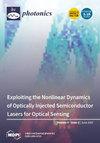通过石墨烯金属表面的三重亮模对称设计双质子诱导透明性
IF 2.1
4区 物理与天体物理
Q2 OPTICS
引用次数: 0
摘要
对石墨烯元表面中的等离子体诱导透明度(PIT)进行动态操控有望用于光开关和调制等光电器件;然而,以往的设计方法仅限于一种或两种亮/暗模式,而通过石墨烯元表面中的三重亮模式实现双PIT窗口却鲜有提及。在这里,我们证明了通过对称设计的石墨烯元表面(由石墨烯中心十字(GCC)和石墨烯矩形环(GRR)阵列组成)可以实现双 PIT。GCC 支持来自电偶极子(ED)的亮模,GRR 支持来自电偶极子和电四极子(EQ)的两个非孤立亮模(由于 C2v 对称性破缺),这三个亮模的共振耦合诱导出双 PIT 窗口。我们提出了一个三重耦合振荡器模型(TCM)来评估双 PIT 现象的传输性能,其结果与有限差分时域(FDTD)方法十分吻合。此外,除了 GRR 的 Y 方向长度外,双 PIT 窗口对石墨烯元表面结构参数的变化具有鲁棒性。通过改变石墨烯的载流子迁移率,可以有效地调整两个 PIT 窗口的振幅。改变石墨烯的费米级可实现双 PIT 的动态调制,在调制度(MD)和插入损耗(IL)方面都有良好的表现。本文章由计算机程序翻译,如有差异,请以英文原文为准。
Symmetry-Engineered Dual Plasmon-Induced Transparency via Triple Bright Modes in Graphene Metasurfaces
Dynamical manipulation of plasmon-induced transparency (PIT) in graphene metasurfaces is promising for optoelectronic devices such as optical switching and modulating; however, previous design approaches are limited within one or two bright/dark modes, and the realization of dual PIT windows through triple bright modes in graphene metasurfaces is seldom mentioned. Here, we demonstrate that dual PIT can be realized through a symmetry-engineered graphene metasurface, which consists of the graphene central cross (GCC) and graphene rectangular ring (GRR) arrays. The GCC supports a bright mode from electric dipole (ED), the GRR supports two nondegenerate bright modes from ED and electric quadrupole (EQ) due to the C2v symmetry breaking, and the resonant coupling of these three bright modes induces the dual PIT windows. A triple coupled-oscillator model (TCM) is proposed to evaluate the transmission performances of the dual PIT phenomenon, and the results are in good agreement with the finite-difference time-domain (FDTD) method. In addition, the dual PIT windows are robust to the variation of the structural parameters of the graphene metasurface except for the y-directioned length of the GRR. By changing the carrier mobility of graphene, the amplitudes of the two PIT windows can be effectively tuned. The alteration of the Fermi level of graphene enables the dynamic modulation of the dual PIT with good performances for both modulation degree (MD) and insertion loss (IL).
求助全文
通过发布文献求助,成功后即可免费获取论文全文。
去求助
来源期刊

Photonics
Physics and Astronomy-Instrumentation
CiteScore
2.60
自引率
20.80%
发文量
817
审稿时长
8 weeks
期刊介绍:
Photonics (ISSN 2304-6732) aims at a fast turn around time for peer-reviewing manuscripts and producing accepted articles. The online-only and open access nature of the journal will allow for a speedy and wide circulation of your research as well as review articles. We aim at establishing Photonics as a leading venue for publishing high impact fundamental research but also applications of optics and photonics. The journal particularly welcomes both theoretical (simulation) and experimental research. Our aim is to encourage scientists to publish their experimental and theoretical results in as much detail as possible. There is no restriction on the length of the papers. The full experimental details must be provided so that the results can be reproduced. Electronic files and software regarding the full details of the calculation and experimental procedure, if unable to be published in a normal way, can be deposited as supplementary material.
 求助内容:
求助内容: 应助结果提醒方式:
应助结果提醒方式:


